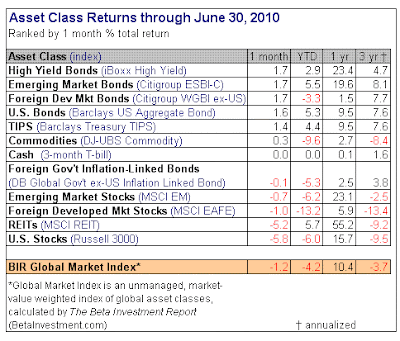June was another rough month for risky assets, although the losses were considerably deeper with U.S. stocks from a dollar-based return perspective. REITs also took a hit: for the first time since the opening months of 2009, real estate securities dropped by more than 5% for the second month running. Bonds, on the other hand, did quite well in June. With the threat of deflation taking a toll on investor sentiment, the safety of fixed-income (even at unusually low yields) attracted capital flows last month like moths to a flame. And commodities overall, as per the Dow Jones-UBS Commodity Index, managed to eke out a fraction gain.
As our table below shows, the worst of the red ink was largely contained in REITs and domestic equities. That helped keep losses in the Global Market Index to a relatively light decline of 1.2% in June.

But don't let June mask the broader trend. Stepping back and considering the first half of 2010, there are more losses, and deeper ones among the major asset classes. Commodities, for instance, are down by nearly 10% and foreign developed stocks have retreated by more than 13% in dollar terms—the steepest decline for the major asset classes on a year-to-date basis through June’s close. The global flight into the dollar via Treasuries has helped push the greenback higher so far this year. In turn, that exacerbates any losses in foreign assets when priced in dollars.
Unsurprisingly, the proprietary benchmark for The Beta Investment Report posted middling results relative to the major asset classes during this year’s first six months. The Global Market Index has shed 4.2% this year through June 30.
What's convincing the crowd to run for cover? Deflation worries, which may show up in any number of ways in the weeks and months ahead. The leading concern is that the value of GDP will fall. In other words, renewed concern about recession is again at the top of the worry list.
The sentiment shift was evident in May, when the markets demanded a new and lower price for risk. That's another way of saying that investors demanded a higher expected return, a preference that may have legs. Midway in May, we noted that there were warning signs to consider, including the simultaneous rise of gold and the dollar. The two usually move in opposite directions, unless risk aversion is on the rise. Until the economic data offers compelling evidence to the contrary, the markets aren't likely to reconsider the bearish outlook that's prevailed for the last two months.
This morning's update on initial jobless claims certainly doesn't provide an incentive to think positively. New filings for unemployment benefits jumped 13,000 last week to a total of 472,000. As we've been arguing for some time, the trendless trend in jobless claims is a sore point in the economic recovery and one that threatens to do serious damage to sentiment the longer it rolls on. For the moment, it's rolling on, as the second chart below reminds.

Tomorrow brings word of the broad employment picture for June. Unfortunately, the outlook isn't rosy. The consensus forecast calls for a retreat of 100,000 in last month's nonfarm payrolls, according to Briefing.com.
In fact, the markets have been pricing in a fresh round of bad news for the better part of the last two months. As we opined in January, the odds looked pretty good that 2010 would be a much more challenging year compared with 2009--a contrarian view at the time. Indeed, saving the economy from collapse was relatively easy, and markets reacted according in 2009 by repricing risk higher (and expected return lower). Keeping the reflation going, however, is something else. Macroeconomics has learned much over the decades about how to sidestep a full-blown meltdown. Figuring out what needs to be done to keep the rebound going in the wake of a deep financial crisis is on much more tenuous intellectual ground.
For what it's worth, we're still not convinced that a new recession is imminent. Nonetheless, the odds of stagnation, or worse, are rising. Much depends on how the Fed reacts in the coming weeks. Yesterday we argued that the central bank needs to keep the pace of money supply rising at a healthy clip, at least for the time being. Instead, the Fed has let the annual pace of change in the money supply drop like a rock. Unless that changes, and soon, the economic outlook may continue to deteriorate further.
This article has been republished from James Picerno's blog, The Capital Spectator.
No comments:
Post a Comment